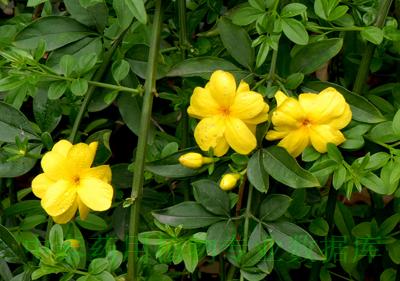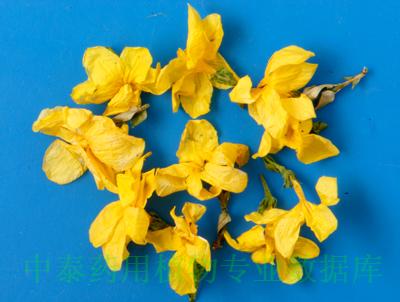| [English Name] | Winter Jasmine Flower | |
| [Chinese Name] | 迎春花 | |
| [Pinying Name] | Yingchunhua | |
| [Latin Name] | Jasmini Nudiflori Flos | |
| [Genera] | Oleaceae | |
| [Efficacy] | Antipyretic drug | |
| [Pictures] | Plant picture | Drug picture |

|

|
|
| [Alias] | ||
| [Source] | ||
| [Plant morphology] | ||
| [Distribution] | ||
| [Gathering and processing] | ||
| [Characteristics] | ||
| [Ecology] | It prefers light,resistants shade slightly and cold,is afraid of waterlogging,can overwintering open ground in the North of China and yanling,requires warm and moist climate,loose、fertile and well-drained sandy soil,grows vigorously in acid soil,but grows unwell in alkaline soil. Germination ability of the root is strong. Touchdown part of branches can take root easily. | |
| [Chemical composition] | ||
| [Pharmacological activities] |
1 Jasminumnudiflorum lindl extract for analgesia and sedation: To observe the analgesic effect and sedation effect ofjasminum nudiflorum lind (JNL) extract in mice through writhing body test, hotplate and electric stimulation. The experiments were conducted in theDepartment of Pharmacology, Gannan Medical College from April to June 2003.Fifty mice were randomly divided into five groups with 10 in each group: salinegroup intraperitoneal injection 20 mL/kg, 5, 10, 20 g/kg JNL extract groups and0.01 g/kg morphine group. After 30 minutes, each mouse was administrated with0.2 mL 6 g/L glacial acetic acid through intraperitoneal injection, and thetimes of writhing body was recorded within 20 minutes. Forty female mice wererandomly divided into saline group, 10 g/kg, 20 g/kg JNL extract groups and 0.2g/kg amidopyrine group with 10 rats in each. The pain threshold value wasdetermined by hot plate test at 15, 30 and 60 minutes after administration.Forty qualified mice were randomly divided into saline group, 5 g/kg, 10 g/kgJNL extract groups, 0.01 g/kg morphine group with 10 rats in each. The rate ofanalgesia was determined by electric stimulation at minutes 30, 45 and 60 afteradministration. Forty mice were randomly divided into four groups with 10 ratsin each. Each mouse was put in suspension cage and wave shape was recorded in10 minutes, whereafter were treated with 20 mL/kg saline, 5 g/kg, 10 g/kg JNLextract and 0.005 g/kg diazepam through intraperitoneal injection. After 30minutes each mouse was put in suspension cage again and wave shape was recordedfor 5 minutes. Forty mice were randomly divided into saline group, JNL groupsof 10 g/kg, 20 g/kg and diazepam group of 0.005 g/kg. Thirty minutes afteradministration, they were given sodium pentobarbital of 50 mg/kg throughintraperitoneal injection, eventually sleeping duration of mice were recorded.Totally 210 included mice entered the result analysis. In the writhing bodytest, the times of writhing body in the 5, 10 and 20 g/kg JNL extract groupsand the morphine group were significantly lower than that in the saline group,which had significant difference (3.2±3.1),0,(1.9±3.5),0,(84.7±15.1) times, P<0.001.In the hot plate test, the pain threshold was higher in the 10, 20 g/kg JNLextract groups and amidopyrine group at minutes 15 and 30 after administrationthan in the saline group which had significant difference (43.5±12.1), (57.2±8.9),(60.0±0.0), (28.2±3.4) s; (44.7±11.2), (60.0±0.0), (60.0±0.0), (27.9±4.3) s, P<0.01;The pain threshold was higher in the 20 g/kg JNL extract group and amidopyrinegroup at minute 60 after administration than in the saline group, which hadsignificant difference (60.0±0.0), (56.9±4.9), (26.4±3.8) s, P<0.01. Therewas no significant difference between the 10 g/kg JNL extract group and salinegroup. The analgesia rate due to electric stimulation in the 5, 10 g/kg JNLextract group and morphine group at minutes 30 and 45 after administration washigher than that in the saline group, which had significant difference (50%, 60%,70%; 60%, 70%, 100%, P<0.05-0.01). The analgesia rate due to electricstimulation in the 10 g/kg JNL extract group and morphine group at minute 60after administration was higher than that in the saline group, which hadsignificant difference (80%, 90%, P<0.01). There was no significantdifference between the 5 g/kg JNL extract group and saline group. In theautonomic activities test, the numbers of big wave and midwave were lower inthe 5, 10 g/kg JNL extract groups and diazepam group at minutes 30 and 5 afteradministration than in the saline group, which had significant difference(9.7±5.2), (3.4±4.0), (2.7±2.3), (28.0±8.4), P<0.001. Sleeping duration tosodium pentobarbital in the 20 g/kg JNL extract group and diazepam group washigher than in the saline group, which had significant difference (77.6±11.2), (103.6±13.6),(34.4±6.7) min, P<0.001. There was no significant difference between the 10g/kg JNL extract group and the saline group. The JNL extract has analgesic andsedation effects [1]. 2 Jasminum nudiflorumLindl’s extract on immunity effect in mice. The extract can significantlyimprove immune apparatus index, phagocytic index and E-rosette ratio.Theexperiment proves that the extract of Jasminum nudiflorum Lindl can enhance theimmunity in mice [2]. 3 Antiarrhythmia effectson JNL extract: The conventional antiarrhythmia methods were used. JNL extractwas effective in preventing ventricular fibrillation induced by chloroform inmice. However, it could not prevent ventricular fibrillation induced by calciumchloride in mice. JNL extract has the effect of therapy on antiarrhythmiainduced by aconitine in rats. The arrhythmia induced by adrenalin in rabbitswas antagonized by JNL extract. JNL extract has antiarrhythmia effect [3]. 4 Protective effect ofJasminum nudiflorum Lindl water extract against cerebral ischemia-reperfusioniniury. The survival time of mice was recorded after ligating bilateral commoncarotid arteries and vagus nerves in mice. The activity of superoxide dismutase(SOD), the contents malondialdehyde (MDA) and glutathione (GSH) were determinedby spectrophotometry in brain homogenate of mice. JNLWE significantly prolongedthe survival time of mice, enhanced the activity of SOD, degraded the contentsof MDA and raised the contents of GSH in the brain induced byischemia-reperfusion. JNLWE has protective effect against cerebral ischemia- reperfusioninjury via its antioxidant activity [4]. |
|
| [Clinical trial] | ||
| [Properties] | ||
| [Medical and other Uses] | ||
| [Dosage] | ||
| [Cautions] | ||
| [Traditional usage] |
1. Ecthyma 2. Traumatic injury,hemorrhage due to the knife cutting 3. Fever and headache 4. Sore throat 5. Heat and pain stranguria 6. Unknown pyogenic infections, high fever 7. Pyogenic infections, malignant sore |
|
| [Toxicological studies] | ||
| [Pharmaceutical preparations] | ||
| [References] |
Pharmacology Actions: [1] Xiao-ning Yang, Xian-huo Huang, Jing Zeng et al., Jasminum nudiflorum lindl extract for analgesia and sedation, Chinese Journal of Clinical Rehabilitation, 2006 (35) pp.50-52. [2] Hui Lu, Shan-yuan Zhu, Jie Yu et al., The Effect of Jasminum Nudiflorum Lindlps Extract on the Immunity in Mice, Journal of Nanjing Xiaozhuang Universiry, 2008 (06) pp. 25-127. [3] Xian-hua Huang, Xiao Hu, Huo-ying Pan et al., Effect of Jasminum nudiflorum Lindl( JNL) Extract on antiarrhythmia, Pharmacology and Clinics of Chinese Materia Medica, 2006 (06) pp. 49-51. [4] Gui-hua Huang, Chang-liang Huang, Wei-wei Song et al., Protective effect of Jasminum nudiflorum Lindlwater extract against cerebral ischem ia-reperfusion inury, Pharmacology and Clinics of Chinese Materia Medica, 2007 (05) pp.135-137.
|
|